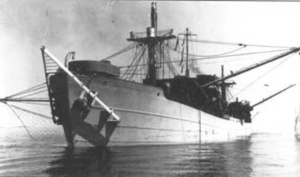Protecting the Fleet

The gun crew of a defensively equipped merchant ship take part in a drill at Halifax, Nova Scotia in 1942. A merchant seaman is passing a shell to the Royal Navy gunners.
During the Second World War, Canadian and British shipping were the responsibility of the Royal Canadian Navy and the Royal Navy. Part of the RCN’s role involved protecting the merchant ships’ crews and cargo.
This important task fell to the DEMS (Defensively Equipped Merchant Ship) gunners, men drawn mainly from the RCNVR (Royal Canadian Naval Volunteer Reserve).
In accordance with international law, they signed ship’s articles and were paid a nominal salary by the shipping company that operated the vessel. At first, these sailors had a very small Canadian-flagged fleet to protect. However, an extensive Canadian ship building programme caused the merchant fleet to expand dramatically.
From late 1942 the number of DEMS men afloat increased rapidly until, by mid-1945, some 1800-2000 were in that branch of the RCN. All but about 200 were gunners, the remainder being Signalmen, Telegraphists and Coders serving under the Convoy Commodore.
The DEMS sailors were usually selected after completing basic training and were sent to several Canadian locations to qualify as Seaman Gunners (3rd Class) before proceeding to sea. Later they could advance to Gunlayer (2nd Class) and Chief/Petty Officer (1st Class.) The graduates were then sent off to defend 10,000 ton ships, 13 of which were tankers, 4,799 ton vessels, 3,700 ton coasters, and an unknown number of smaller but essential vessels such as ferries sailing in Canadian and Newfoundland waters.

This photo shows the paravane gear and anti-torpedo nets on a new Canadian-built cargo vessel. Image originally from the collection of Merchant Mariner Captain Hill Wilson. Photo courtesy of Cliff McMullen’s online article on Defensively Equipped Merchant Ships.
Although built to a British design, the 10,000 ton DEMS-protected ships constructed in Canada were owned by the Park Steamship Line, an arm of the federal Department of Munitions and Supply, and were operated by Canadian shipping companies. Named after Canadian parks, the ships of 10,000 tons were more heavily armed than a corvette, and at least equal in firepower to a frigate.
For the most part, junior rates (ABs, Leading Seamen) were responsible for the ship’s defence, its cargo of essential items, and its crew.
DEMS sailors steamed to every theatre of war and they paid the price: imperfect records indicate that 51 were lost, of whom 34 were believed to have been serving in ships flagged by other Allied nations.
 CFB Esquimalt Naval and Military Museum
CFB Esquimalt Naval and Military Museum CFB Esquimalt Naval and Military Museum
CFB Esquimalt Naval and Military Museum CFB Esquimalt Naval and Military Museum
CFB Esquimalt Naval and Military Museum CFB Esquimalt Naval and Military Museum
CFB Esquimalt Naval and Military Museum CFB Esquimalt Naval and Military Museum
CFB Esquimalt Naval and Military Museum CFB Esquimalt Naval and Military Museum
CFB Esquimalt Naval and Military Museum CFB Esquimalt Naval and Military Museum
CFB Esquimalt Naval and Military Museum CFB Esquimalt Naval and Military Museum
CFB Esquimalt Naval and Military Museum CFB Esquimalt Naval and Military Museum
CFB Esquimalt Naval and Military Museum CFB Esquimalt Naval and Military Museum
CFB Esquimalt Naval and Military Museum CFB Esquimalt Naval and Military Museum
CFB Esquimalt Naval and Military Museum CFB Esquimalt Naval and Military Museum
CFB Esquimalt Naval and Military Museum CFB Esquimalt Naval and Military Museum
CFB Esquimalt Naval and Military Museum CFB Esquimalt Naval and Military Museum
CFB Esquimalt Naval and Military Museum